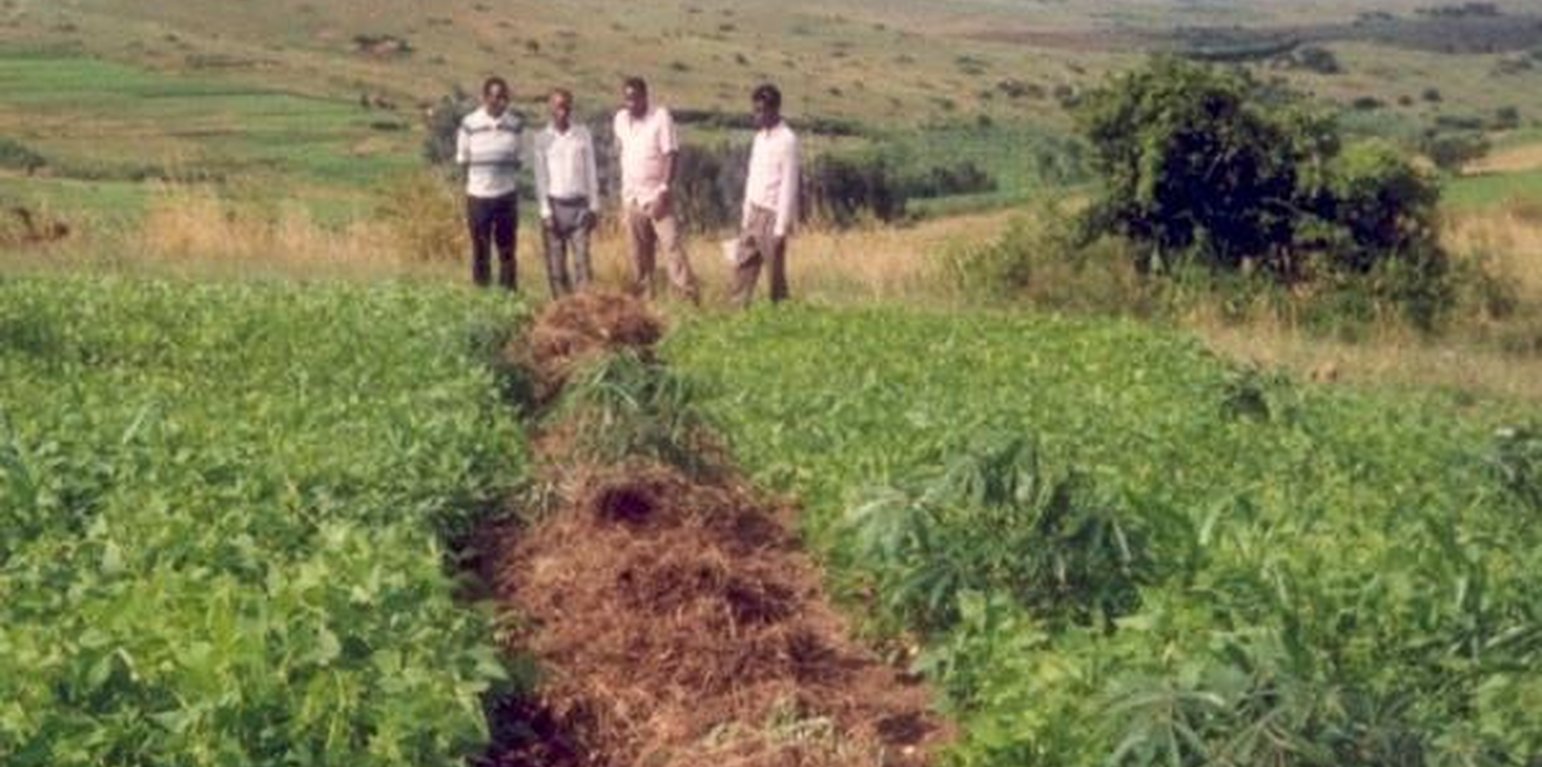Improved trash lines
(ยูกันดา)
Emikikizo (Lukiga)
คำอธิบาย
Weeds and crop residues laid in bands across the slope of annual crop fields to conserve soil and water, and to incorporate organic matter into the soil after decomposition.
Trash lines of organic material across the slope constitute a traditional land husbandry practice in south-west Uganda. These traditional, ‘unimproved’, trash lines are beneficial, but even better is an improved version designed through Participatory Technology Development (PTD). Improved trash lines are smaller, closer spaced, and of longer duration than the traditional type. They are more effective in controlling runoff and maintaining soil fertility.
All trash lines (improved and traditional) are composed of cereal stover (straw) and weeds that are collected during primary cultivation (hand hoeing), and heaped in strips along the approximate contour. Creeping grasses should not be used in trash lines: they can alternatively be decomposed in bundles, and then used as mulch in nearby banana plantations. Trash lines are used in hillside fields where annual crops, including sorghum, finger millet, beans and peas, are grown. The recommended spacing between the improved trash lines is 5-10 m, depending
on the slope: the steeper the closer. The amount of material available determines the cross section of each trash line (typically ±0.5 m wide and ±0.3 m high). Improved trash lines are left in place for four seasons (there are two seasons a year in Kabale) before they are dug into the soil. Much of the material used has, by this time, decomposed or been eaten by termites. Through incorporation into the topsoil, they improve soil fertility acting effectively as ‘mobile compost strips’. New trash lines are then established between the sites of the former lines. Upkeep comprises removal of weeds that sprout within the lines - before they set seed - and the addition of more trash during each new cultivation and weeding cycle.
Improved trash lines are multipurpose in retarding dispersed runoff while, as discussed, maintaining soil fertility. They are a low-cost option for soil and water conservation. However, they need to be complemented by other measures on the steeper slopes. The climate in this part of Uganda is subhumid, with a bimodal rainfall regime, and average annual rainfall of around 800 mm. Hill tops are used for grazing, the lower slopes are cultivated with annual crops (where the trash lines are found) and the valleys are dedicated to bananas and other cash crops. Families are large: 8-10 persons, and the population density is high, at nearly 200 persons/km2.
สถานที่
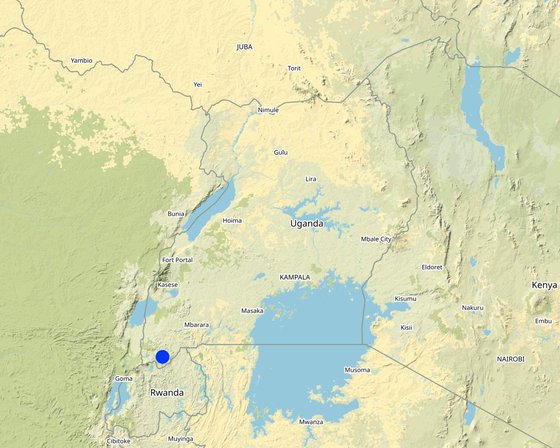
สถานที่: Kabale district, Kabale, ยูกันดา
ตำนวนการวิเคราะห์เทคโนโลยี:
ตำแหน่งทางภูมิศาสตร์ของสถานที่ที่ถูกเลือ
การเผยแพร่ของเทคโนโลยี: กระจายไปอย่างสม่ำเสมอในพื้นที่ (approx. 0.1-1 ตร.กม.)
In a permanently protected area?:
วันที่ในการดำเนินการ: มากกว่า 50 ปี (แบบดั้งเดิม)
ประเภทของการแนะนำ
-
ด้วยการริเริ่มของผู้ใช้ที่ดินเอง
-
เป็นส่วนหนึ่งของระบบแบบดั้งเดิมที่ทำก้นอยู่ (> 50 ปี)
-
ในช่วงการทดลองหรือการทำวิจัย
-
ทางโครงการหรือจากภายนอก
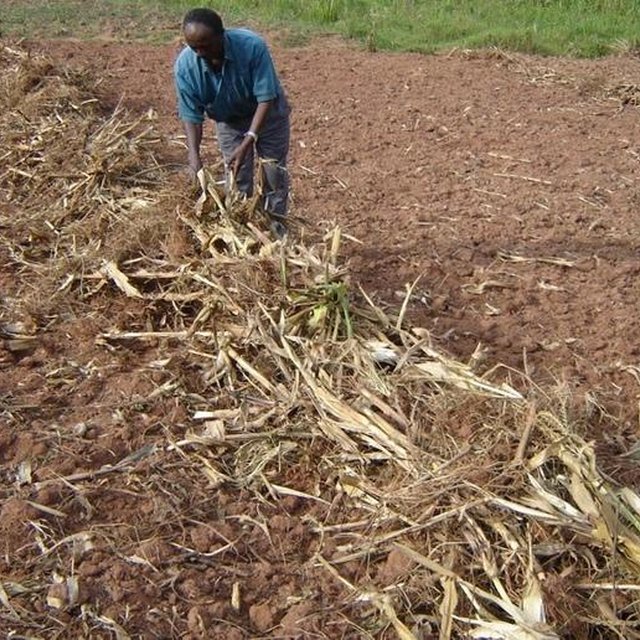
Extension agent with trash lines - newly formed from cereal residues. (William Critchley)
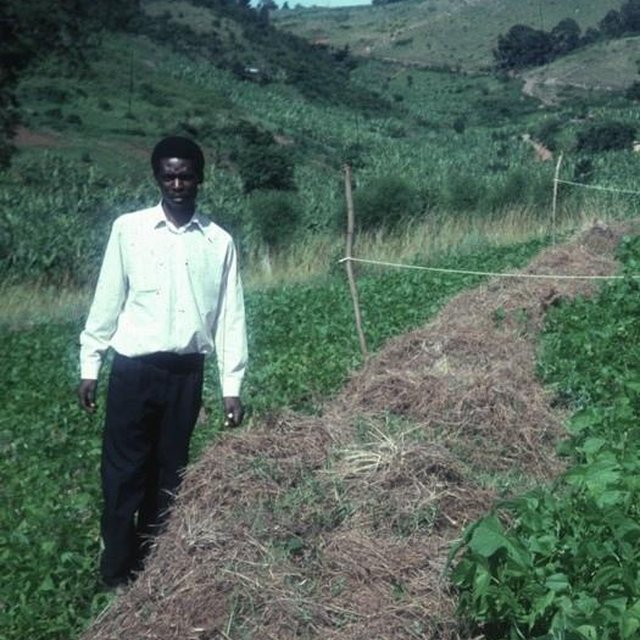
-
จุดประสงค์หลัก
-
ปรับปรุงการผลิตให้ดีขึ้น
-
ลด ป้องกัน ฟื้นฟู การเสื่อมโทรมของที่ดิน
-
อนุรักษ์ระบบนิเวศน์
-
ป้องกันพื้นที่ลุ่มน้ำ/บริเวณท้ายน้ำ โดยร่วมกับเทคโนโลยีอื่นๆ
-
รักษาสภาพหรือปรับปรุงความหลากหลายทางชีวภาพ
-
ลดความเสี่ยงของภัยพิบัติ
-
ปรับตัวเข้ากับการเปลี่ยนแปลงภูมิอากาศของโลก สภาพภูมิอากาศที่รุนแรงและผลกระทบ
-
ชะลอการเปลี่ยนแปลงภูมิอากาศของโลกและผลกระทบ
-
สร้างผลกระทบทางด้านเศรษฐกิจที่เป็นประโยชน์
-
สร้างผลกระทบทางด้านสังคมที่เป็นประโยชน์
การใช้ที่ดิน
-
พื้นที่ปลูกพืช
- การปลูกพืชล้มลุกอายุปีเดียว: cereals - millet, cereals - sorghum, legumes and pulses - beans, legumes and pulses - peas
- การปลูกพืชยืนต้นที่ไม่มีเนื้อไม้ : banana/plantain/abaca
- การปลูกไม้ยืนต้น ไม้พุ่ม
จำนวนของฤดูเพาะปลูกต่อปี: 2
การใช้น้ำ
-
จากน้ำฝน
-
น้ำฝนร่วมกับการชลประทาน
-
การชลประทานแบบเต็มรูปแบบ
ความมุ่งหมายที่เกี่ยวข้องกับการเสื่อมโทรมของที่ดิน
-
ป้องกันความเสื่อมโทรมของที่ดิน
-
ลดความเสื่อมโทรมของดิน
-
ฟื้นฟูบำบัดที่ดินที่เสื่อมโทรมลงอย่างมาก
-
ปรับตัวกับสภาพความเสื่อมโทรมของที่ดิน
-
ไม่สามารถใช้ได้
ที่อยู่ของการเสื่อมโทรม
-
การกัดกร่อนของดินโดยน้ำ - Wt (Loss of topsoil): การสูญเสียดินชั้นบนหรือการกัดกร่อนที่ผิวดิน
-
การเสื่อมโทรมของดินทางด้านเคมี - Cn (Fertility decline): ความอุดมสมบูรณ์และปริมาณอินทรียวัตถุในดินถูกทำให้ลดลงไป (ไม่ได้เกิดจากสาเหตุการกัดกร่อน)
-
การเสื่อมโทรมของน้ำ - Ha (Aridification): การเกิดความแห้งแล้ง
กลุ่ม SLM
-
การปรับปรุงดิน / พืชคลุมดิน
-
มาตรการปลูกพืชขวางความลาดชัน (cross-slope measure)
-
การเก็บเกี่ยวน้ำ
มาตรการ SLM
แบบแปลนทางเทคนิค
ข้อมูลจำเพาะด้านเทคนิค
Trash lines without crops (left)
and with crops (beans; right).
The insert shows the stages of the technology: regularly spaced trash lines are kept place for four seasons (1); then decompose over time and are incorporated into the soil (2); and finally new trash lines are placed between the previous strips (3).
Technical knowledge required for field staff / advisors: low
Technical knowledge required for land users: low
Main technical functions: control of dispersed runoff: impede / retard, increase of infiltration, increase in soil fertility
Secondary technical functions: control of dispersed runoff: retain / trap, increase in organic matter, improvement of soil structure, sediment harvesting
Agronomic measure: mulching, trash lines
Material/ species: weed residue, sorghum
Remarks: along contour
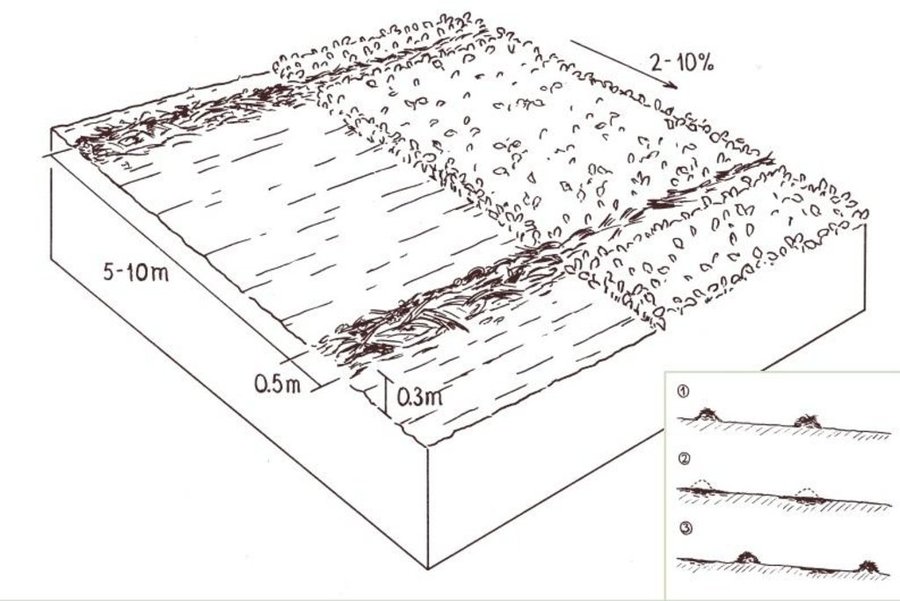
Author: Mats Gurtner
การจัดตั้งและการบำรุงรักษา: กิจกรรม ปัจจัยและค่าใช้จ่าย
การคำนวนต้นทุนและค่าใช้จ่าย
- ค่าใช้จ่ายถูกคำนวน
- สกุลเงินที่ใช้คำนวณค่าใช้จ่าย Uganda Shillings
- อัตราแลกเปลี่ยน (ไปเป็นดอลลาร์สหรัฐ) คือ 1 ดอลลาร์สหรัฐ = 1000.0 Uganda Shillings
- ค่าจ้างเฉลี่ยในการจ้างแรงงานต่อวันคือ 1.00
ปัจจัยที่สำคัญที่สุดที่มีผลต่อค่าใช้จ่าย
Labour, need to collect and heap the trashlines material in lines above the slope
กิจกรรมเพื่อการจัดตั้ง
n.a.
ปัจจัยและค่าใช้จ่ายของการจัดตั้ง
| ปัจจัยนำเข้า |
หน่วย |
ปริมาณ |
ค่าใช้จ่ายต่อหน่วย (Uganda Shillings) |
ค่าใช้จ่ายทั้งหมดต่อปัจจัยนำเข้า (Uganda Shillings) |
%ของค่าใช้จ่ายที่ก่อให้เกิดขึ้นโดยผู้ใช้ที่ดิน |
|
แรงงาน
|
| Labour |
ha |
1.0 |
25.0 |
25.0 |
100.0 |
|
อุปกรณ์
|
| Tools |
ha |
1.0 |
5.0 |
5.0 |
100.0 |
| ค่าใช้จ่ายทั้งหมดของการจัดตั้งเทคโนโลยี |
30.0 |
|
| Total costs for establishment of the Technology in USD |
0.03 |
|
กิจกรรมสำหรับการบำรุงรักษา
-
During land cultivation, existing (old) trash lines are dug. 2. New trash lines are then created exactly between the (cross-slope) (ช่วงระยะเวลา/ความถี่: Dry season / each cropping season)
-
The size of the trash lines depends on the amount of trash available, (ช่วงระยะเวลา/ความถี่: Dry season)
-
Weeds are added to the trash lines, and, in preparation for the second (ช่วงระยะเวลา/ความถี่: Second season)
-
Trash lines are kept free of growing weeds and built up with more (ช่วงระยะเวลา/ความถี่: Third and fourth seasons)
-
Trash lines are kept free of growing weeds and built up with moretrash. Full cycle for improved trash lines: 4 seasons (2 years) (ช่วงระยะเวลา/ความถี่: None)
สิ่งแวดล้อมทางธรรมชาติ
ปริมาณน้ำฝนเฉลี่ยรายปี
-
< 250 ม.ม.
-
251-500 ม.ม.
-
501-750 ม.ม.
-
751-1,000 ม.ม.
-
1,001-1,500 ม.ม.
-
1,501-2,000 ม.ม.
-
2,001-3,000 ม.ม.
-
3,001-4,000 ม.ม.
-
> 4,000 ม.ม.
เขตภูมิอากาศเกษตร
-
ชื้น
-
กึ่งชุ่มชื้น
-
กึ่งแห้งแล้ง
-
แห้งแล้ง
ข้อมูลจำเพาะเรื่องภูมิอากาศ
ปริมาณเฉลี่ยฝนรายปีในหน่วยมม. 800.0
Thermal climate class: tropics
ความชัน
-
ราบเรียบ (0-2%)
-
ลาดที่ไม่ชัน (3-5%)
-
ปานกลาง (6-10%)
-
เป็นลูกคลื่น (11-15%)
-
เป็นเนิน (16-30%)
-
ชัน (31-60%)
-
ชันมาก (>60%)
ภูมิลักษณ์
-
ที่ราบสูง/ที่ราบ
-
สันเขา
-
ไหล่เขา
-
ไหล่เนินเขา
-
ตีนเนิน
-
หุบเขา
ความสูง
-
0-100 เมตร
-
101-500 เมตร
-
501-1,000 เมตร
-
1,001-1,500 เมตร
-
1,501-2,000 เมตร
-
2,001-2,500 เมตร
-
2,501-3,000 เมตร
-
3,001-4,000 เมตร
-
> 4,000 เมตร
เทคโนโลยีถูกประยุกต์ใช้ใน
-
บริเวณสันเขา (convex situations)
-
บริเวณแอ่งบนที่ราบ (concave situations)
-
ไม่เกี่ยวข้อง
ความลึกของดิน
-
ตื้นมาก (0-20 ซ.ม.)
-
ตื้น (21-50 ซ.ม.)
-
ลึกปานกลาง (51-80 ซ.ม.)
-
ลึก (81-120 ซ.ม.)
-
ลึกมาก (>120 ซ.ม.)
เนื้อดิน (ดินชั้นบน)
-
หยาบ/เบา (ดินทราย)
-
ปานกลาง (ดินร่วน ทรายแป้ง)
-
ละเอียด/หนัก (ดินเหนียว)
เนื้อดิน (> 20 ซม. ต่ำกว่าพื้นผิว)
-
หยาบ/เบา (ดินทราย)
-
ปานกลาง (ดินร่วน ทรายแป้ง)
-
ละเอียด/หนัก (ดินเหนียว)
สารอินทรียวัตถุในดิน
-
สูง (>3%)
-
ปานกลาง (1-3%)
-
ต่ำ (<1%)
น้ำบาดาล
-
ที่ผิวดิน
-
<5 เมตร
-
5-50 เมตร
-
> 50 เมตร
ระดับน้ำบาดาลที่ผิวดิน
-
เกินพอ
-
ดี
-
ปานกลาง
-
ไม่ดีหรือไม่มีเลย
คุณภาพน้ำ (ยังไม่ได้รับการบำบัด)
-
เป็นน้ำเพื่อการดื่มที่ดี
-
เป็นน้ำเพื่อการดื่มที่ไม่ดี (จำเป็นต้องได้รับการบำบัด)
-
เป็นน้ำใช้เพื่อการเกษตรเท่านั้น (การชลประทาน)
-
ใช้ประโยชน์ไม่ได้
ความเค็มของน้ำเป็นปัญหาหรือไม่?
การเกิดน้ำท่วม
ความหลากหลายทางชนิดพันธุ์
ความหลากหลายของแหล่งที่อยู่
ลักษณะเฉพาะของผู้ใช้ที่ดินที่ประยุกต์ใช้เทคโนโลยี
เป้าหมายทางการตลาด
-
เพื่อการยังชีพ (หาเลี้ยงตนเอง)
-
mixed (subsistence/ commercial)
-
ทำการค้า/การตลาด
รายได้จากภายนอกฟาร์ม
-
< 10% ของรายได้ทั้งหมด
-
10-50% ของรายได้ทั้งหมด
-
> 50% ของรายได้ทั้งหมด
ระดับของความมั่งคั่งโดยเปรียบเทียบ
-
ยากจนมาก
-
จน
-
พอมีพอกิน
-
รวย
-
รวยมาก
ระดับของการใช้เครื่องจักรกล
-
งานที่ใช้แรงกาย
-
การใช้กำลังจากสัตว์
-
การใช้เครื่องจักรหรือเครื่องยนต์
อยู่กับที่หรือเร่ร่อน
-
อยู่กับที่
-
กึ่งเร่ร่อน
-
เร่ร่อน
เป็นรายบุคคลหรือกลุ่ม
-
เป็นรายบุคคล/ครัวเรือน
-
กลุ่ม/ชุมชน
-
สหกรณ์
-
ลูกจ้าง (บริษัท รัฐบาล)
อายุ
-
เด็ก
-
ผู้เยาว์
-
วัยกลางคน
-
ผู้สูงอายุ
พื้นที่ที่ใช้ต่อครัวเรือน
-
< 0.5 เฮกตาร์
-
0.5-1 เฮกตาร์
-
1-2 เฮกตาร์
-
2-5 เฮกตาร์
-
5-15 เฮกตาร์
-
15-50 เฮกตาร์
-
50-100 เฮกตาร์
-
100-500 เฮกตาร์
-
500-1,000 เฮกตาร์
-
1,000-10,000 เฮกตาร์
-
>10,000 เฮกตาร์
ขนาด
-
ขนาดเล็ก
-
ขนาดกลาง
-
ขนาดใหญ่
กรรมสิทธิ์ในที่ดิน
-
รัฐ
-
บริษัท
-
เป็นแบบชุมชนหรือหมู่บ้าน
-
กลุ่ม
-
รายบุคคล ไม่ได้รับสิทธิครอบครอง
-
รายบุคคล ได้รับสิทธิครอบครอง
สิทธิในการใช้ที่ดิน
-
เข้าถึงได้แบบเปิด (ไม่ได้จัดระเบียบ)
-
เกี่ยวกับชุมชน (ถูกจัดระเบียบ)
-
เช่า
-
รายบุคคล
สิทธิในการใช้น้ำ
-
เข้าถึงได้แบบเปิด (ไม่ได้จัดระเบียบ)
-
เกี่ยวกับชุมชน (ถูกจัดระเบียบ)
-
เช่า
-
รายบุคคล
เข้าถึงการบริการและโครงสร้างพื้นฐาน
ผลกระทบ
ผลกระทบทางด้านเศรษฐกิจและสังคม
ผลกระทบด้านสังคมและวัฒนธรรม
ผลกระทบนอกพื้นที่ดำเนินการ
รายได้และค่าใช้จ่าย
ผลประโยชน์ที่ได้รับเปรียบเทียบกับค่าใช้จ่าย
ผลประโยชน์ที่ได้รับเปรียบเทียบกับค่าใช้จ่ายในการบำรุงรักษา
ผลตอบแทนระยะสั้น
ด้านลบอย่างมาก
ด้านบวกอย่างมาก
ผลตอบแทนระยะยาว
ด้านลบอย่างมาก
ด้านบวกอย่างมาก
การเปลี่ยนแปลงของสภาพภูมิอากาศ
-
การน้อมเอาความรู้และการปรับใช้
เปอร์เซ็นต์ของผู้ใช้ที่ดินในพื้นที่ที่นำเทคโนโลยีไปใช้
-
ครั้งเดียวหรือเป็นการทดลอง
-
1-10%
-
11-50%
-
> 50%
จากทั้งหมดที่ได้รับเทคโนโลยีเข้ามามีจำนวนเท่าใดที่ทำแบบทันที โดยไม่ได้รับการจูงใจด้านวัสดุหรือการเงินใดๆ?
-
0-10%
-
11-50%
-
51-90%
-
91-100%
เทคโนโลยีได้รับการปรับเปลี่ยนเร็วๆ นี้เพื่อให้ปรับตัวเข้ากับสภาพที่กำลังเปลี่ยนแปลงหรือไม่?
สภาพที่กำลังเปลี่ยนแปลงอันไหน?
-
การเปลี่ยนแปลงแบบค่อยเป็นค่อยไปและสภาพรุนแรงของภูมิอากาศ
-
การเปลี่ยนแปลงของตลาด
-
การมีแรงงานไว้ให้ใช้ (เนื่องจากการอพยพย้ายถิ่นฐาน)
บทสรุปหรือบทเรียนที่ได้รับ
จุดแข็ง: มุมมองของผู้ใช้ที่ดิน
-
Improved trash lines have small but significant advantages over the traditional trash lines (which are beneficial themselves) in terms of (a) less labour (b) improved crop performance
How can they be sustained / enhanced? Continue with farmer-to-farmer visits for this to be explained.
จุดแข็ง: ทัศนคติของผู้รวบรวมหรือวิทยากรคนอื่นๆ
-
The technology is very simple and uses locally available material. It is easy to understand, being a modification of an existing tradition
How can they be sustained / enhanced? Continue with farmer-to-farmer visits for first hand learning.
-
Multiple ecological and SWC benefits: improves soil fertility, reduces erosion, increases infiltration etc
How can they be sustained / enhanced? Continue to encourage adoption of (and further farmer experimentation with) the improved trash lines.
จุดด้อย/ข้อเสีย/ความเสี่ยง: มุมมองของผู้ใช้ที่ดินแก้ไขปัญหาได้อย่างไร
-
Source of weeds
Pull out weeds before they set seed and don’t use stoloniferous or rhizome-forming (creeping) grasses in trash lines (see picture).
-
trash line harbours pest and diseases
use entirely dry grass or material
จุดด้อย/ข้อเสีย/ความเสี่ยง: ทัศนคติของผู้รวบรวมหรือวิทยากรคนอื่นๆแก้ไขปัญหาได้อย่างไร
-
Where land is limiting, agricultural land which would be used, is lost
uses it as a crop rotation basis
-
The trash lines are not enough on their own to control erosion on the steeper slopes
Introduce/promote supplementary structural remedies such as earth bunds.
-
Competition for crop residues which have an alternative use as livestock fodder and, especially, mulch in banana plantations
Grow hedgerows of shrubs/grasses to increase availability of material for fodder, trash lines and mulching.
การอ้างอิง
ผู้ตรวจสอบ
-
Alexandra Gavilano
-
Fabian Ottiger
-
Joana Eichenberger
วันที่จัดทำเอกสาร: 24 กุมภาพันธ์ 2011
การอัพเดทล่าสุด: 18 พฤศจิกายน 2022
วิทยากร
-
Henry Dan Miiro - ผู้เชี่ยวชาญ SLM
คำอธิบายฉบับเต็มในฐานข้อมูล WOCAT
การจัดทำเอกสารถูกทำโดย
องค์กร
- Ministry of Agriculture, Animal Industry, and Fisheries of Uganda (MAAIF) - ยูกันดา
โครงการ
- Book project: where the land is greener - Case Studies and Analysis of Soil and Water Conservation Initiatives Worldwide (where the land is greener)
การอ้งอิงหลัก
-
Briggs SR et al. Livelihoods in Kamwezi, Kabale District, Uganda.. 1998.: Silsoe Research Institute, UK
-
Mutunga K and Critchley W. Farmer’s initiatives in land husbandry Technical Report No 27. 2001.: Regional Land Management Unit, Nairobi, Kenya
-
Critchley W and Mutunga K .Local innovation in a global context: documenting farmer initiatives in land husbandry through WOCAT Land Degradation and Development (14) pp 143–162. 2003.:
